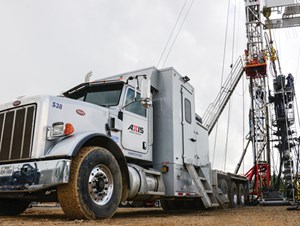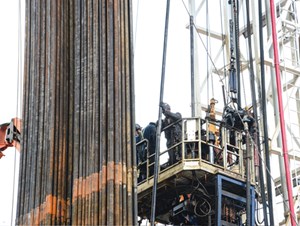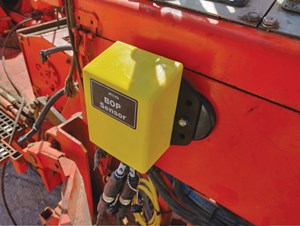Optimizing long lateral completions with advanced stick pipe drill outs
In unconventional wells, coiled tubing has traditionally been the preferred method for drilling out frac plugs after hydraulic stimulation. However, the limitations of this approach are becoming all too clear as operators continue to drill increasingly longer horizontal sections.
As an alternative to coiled tubing, stick pipe drill outs are more reliable and are a cost-effective option in extended-reach laterals. Stick pipe’s ability to drill out every plug in a lateral and leave a fully clean wellbore can be further enhanced by Axis Energy Services’ new approach to service optimization. The company combines integrated services with pre-job planning, real-time data analytics and special-purpose equipment to drive improved operational efficiencies during stick pipe drill outs and reduce cycle times at the well.
COMPARING DRILL OUT OPTIONS
With the memory of the recent downturn still lingering, North American oil and gas producers are committed to optimizing their drilling and completions operations while cultivating long-term cost discipline. In prolific shale producing regions like the Permian basin and Marcellus shale, operators are meeting both objectives by capitalizing on advances in directional drilling technologies to pursue ever-longer horizontal sections.
Longer laterals promise greater production for relatively little additional investment. As such, lateral lengths extending past 10,000 ft are an increasingly attractive drilling target in unconventional wells. However, the trend of drilling longer laterals adds risk, uncertainty and technical challenges to the completion of these wells. Given the industry’s need to keep improving operational efficiencies, operators and service providers alike are continuously looking for new ways to safely and cost-effectively accelerate and improve the way composite plugs are removed after fracking a well.
Coiled tubing is widely used because it has proven to be an effective option for completing shale wells with shorter lateral sections over the past decade. However, beyond a lateral length of approximately 10,000 ft, deployment complications arise that diminish the efficiency of coiled tubing—and its ability to reach the toe of the well.
Increasingly, operators of extended-reach shale wells are recognizing the long-term benefits that stick pipe can provide in lowering the risks and costs of their drilling and completions campaigns, Fig. 1. These benefits are being realized in several key areas:

Reliably consistent performance. Running coiled tubing in longer laterals raises the risk of helical buckling. This phenomenon occurs when the forward motion of the lower end of the tubing string is slowed or interrupted, creating an opposite force that serves to compress the coil. The compressive force continues to build until the lower portion of the string buckles into a helix shape, effectively wrapping itself around the inside of the casing wall. This buckling effect not only increases the fatigue stresses on the coil, but also slows the drill bit’s rate of penetration (ROP), extending the time to drill out each plug.
Stick pipe completions avoid these complications, as the full torque of the power swivel is transmitted to the drill bit. Stick pipe also affords the operator greater control over weight on bit (WOB), helping to ensure the consistent weight and ROP required for a smooth drill out.
“Plug-to-plug, we are faster drilling out with stick pipe versus coiled tubing,” explains a major operator in the Haynesville shale. “Stick pipe gives us a bigger hammer—the full weight of the rigid pipe string behind the bit—to drill through our plugs quickly and effectively.”
Lower likelihood of lockup. In laterals that have not been properly cleaned out or have significant tortuosity, coil has a higher risk of getting stuck. The ability to push or pull the coiled tubing string free—without damaging or separating it—is limited by its tendency to flex or bend and relatively weak pulling strength. Operators can deploy an agitation system toward the end of the coil string, which helps shake the tubing free from tight spots when activated. However, these agitators are typically not effective if the coil gets stuck toward the toe of a 12,000+ ft lateral.
Stick pipe’s constant rotation helps minimize the risk of lockup in the wellbore. In the event it does become stuck, the pipe string provides greater pulling strength than coiled tubing, making it better able to pull free—without the use of an agitator, Fig. 2.

“We’ve tried getting the coiled tubing out past 10,000 ft, but this required much larger quantities of friction reducers, dealing with pipe-on-pipe issues, and facing a greater likelihood of lockup of the tubing string,” a major Permian operator reported. “With stick pipe, we don’t need to worry about these issues… we can consistently reach and drill out every plug in our 10,000+ ft-long laterals.”
A stronger string. Coil fatigue becomes more likely in longer laterals because, unlike jointed stick pipe, the tubing string cannot be rotated as it moves through the well casing. Because the same side of the string drags along the bottom of the casing, the risk of generating flat spots and thinner wall sections on the low side of the coiled tubing is higher. Eventually, this can lead to fatigue-induced pinhole leaks or even complete parting of the tubing string.
In this event, the coiled tubing string must be pulled back to surface. The separated tubing must be retrieved through a costly and time-consuming fishing operation with a workover rig, and a new coil string must be sent to the location to continue the plug drill out process. This can add days or weeks to the cycle time at the well and millions of dollars to the completion operation.
Stick pipe’s constant rotation, by contrast, minimizes the risks of generating flat spots and fatigue-induced damage to the pipe wall.
“We primarily use stick pipe to drill out our composite plugs, partly because it is more resilient than coiled tubing,” explains an operator in the Permian. “Stick pipe is also easier to maneuver in our longer laterals. In terms of the total cost of our drill out operations, using stick pipe on a well service rig is cheaper than bringing in coil.”
Improved hole cleaning. Because the coiled tubing string does not rotate in the hole, the ability to carry debris to surface and clean the hole suffer, particularly at greater lateral lengths. In addition, the string’s small diameter (relative to the casing it is traveling through) results in a reduced annular velocity, further limiting the return fluid’s ability to carry sand, plug debris and other well solids to surface. An operator can compensate by introducing additives that increase the fluid’s viscosity and capacity to transport solids. But this increases the completions spend and may introduce additional processing challenges once the solids-laden fluids reach the surface.
Sand buildup at the heel can restrict the flow of produced fluids to the surface, effectively acting as a choke on the wellbore. Excessive amounts of debris and sand in the produced fluids can damage or hinder the operating efficiency of fluid processing facilities at the surface. To remove this built-up sand and bring production up to desired rates, a well workover may need to be performed far earlier than anticipated.
For a producing well using an electric submersible pump (ESP) as a method of artificial lift, sand and other solids can quickly damage the internals of the pump. The ESP will often have to be pulled out of hole and repaired, an expensive option that routinely costs up to $100,000, not to mention the lost revenue resulting from the loss of production.
Stick pipe’s larger diameter, coupled with its continuous rotation, improves hole cleaning efficiency. The pipe’s rotation creates a viscous coupling effect that carries cuttings and other solids from the low side of the wellbore up to the high side, where the fluid stream’s flow rate is greatest. This in turn improves wellbore cleaning and production by more efficiently moving solids and fluids out of the well when compared to the smaller diameter of coiled tubing. What’s more, stick pipe achieves this without the need for chemical fluid additives to assist solids transport out of the well.
Improving safety and efficiency. Because coiled tubing is deployed in one continuous string, run times in and out of the hole have traditionally been shorter compared with stick pipe. However, advances in rig and completions technology, coupled with real-time data analytics, are helping rig crews eliminate inefficient operations and improve run times for stick pipe. Service companies are further optimizing stick pipe deployments by using dedicated work crews on every job. As rig crews become familiar with each other and the service rig, work efficiency increases reducing run times in and out of the hole.
Stick pipe is also becoming a safer option for high-pressure wells. Modern-day snubbing units include pressure containment equipment such as rams that close around the pipe as each connection is made, Fig. 3. This minimizes safety risks and contains downhole pressures when using stick pipe.

Stick pipe provides another efficiency gain when it comes to getting the well into production faster. With the service rig already on site, the operator avoids the mobilization/demobilization time and charges for the coiled tubing unit. Once the plugs are drilled out, the operator can use the same rig to run the production string and ESP pump into the hole. Eliminating the time required to move a coiled tubing unit offsite and then mobilize a service rig enables production to start much sooner.
The inherent challenges associated with deploying coiled tubing as a completions method in long lateral wellbores are beginning to surpass the reported efficiency gains commonly associated with the method. In fact, operators that drill out their frac plugs using coiled tubing might expect to pay significantly more per plug than if they had used stick pipe.
“Looking just at moving in and out of the hole, it takes longer to deploy stick pipe compared to coiled tubing,” says an operator in the Marcellus. “But when you factor in the lower risk of getting stuck and better hole cleaning efficiencies, stick pipe saves us about $200 for each plug drilled out.”
Dissolvable plugs. Marketed as a means to significantly reduce the total cost of completion operations, dissolvable frac plugs are gaining some market share in unconventional plays. These plugs are formulated to reliably hold pressure during the frac stage and then degrade and disappear after the well is fractured.
Several dissolvable plug manufacturers have reported great success—their plugs dissolve in a matter of just a few days, allowing ever-longer laterals to be completed without the need for coiled tubing or stick pipe drill outs. On the other hand, several operators have observed these plugs taking far longer—up to 10 to 15 days—to break down. The resulting delay in the startup of production, and subsequent loss of revenue, often exceeds the promised savings of reduced drill out runs.
In some wellbore fluids, particularly those at lower downhole temperatures, the plug may not dissolve completely. Rather, it might break down into larger masses or chunks—not fine dust or flakes—that could cause packoff of some of the perforations in the wellbore. The result? Diminished production flow from fewer fractured zones in the well.
“Out here in West Texas, our reservoir temperatures are 120°F and dissolvable plugs aren’t dissolving as promised,” a Permian operator reports. “When we use them in our wells, we still have to drill them out.”
Furthermore, the use of dissolvable plugs does not eliminate the need for a final cleaning stage. Operators will still need a workover rig to perform a cleanup run to remove the many thousands of pounds of proppant, sand and other residual debris from the well before it is brought into production.
And while their costs are coming down, dissolvable plugs are still anywhere from five to ten times more expensive than composite plugs on a unit price basis.
Given these very real production, sand and debris concerns, it is likely that operators will continue to experiment with dissolvable plugs but not commit to a completion strategy that relies on them exclusively. A growing number of operators in unconventional plays are starting to strategically apply dissolvables at or near the toe section of their extended laterals. Composite plugs are still used in the conventional lateral length that a coiled tubing string can reliably reach.
Such a hybrid approach reportedly affords operators some flexibility in their completion design, because they do not have to preplan the entire stimulation program. Rather, they can adjust the relative number of composite-to-dissolvable plugs based on day-to-day economics.However, this option still does not provide the assurance that stick pipe brings in terms of reliably drilling out every plug to maximize production.
Optimizing stick pipe drill outs. To fully capitalize on the efficiency and reliability of stick pipe drill outs in long laterals, operators need to partner with a service provider that has the experience and expertise to complete every lateral to the toe, every time.
The company believes a new service model is required to improve the efficiency of extended-reach drill outs, with the ultimate goal of minimizing cycle time at the well. The model incorporates several key advantages:
- Pre-job planning, a common step in coiled tubing jobs and one that the company is bringing to stick pipe drill outs to identify and mitigate downhole issues that could lead to delays.
- Real-time data analytics to better understand downhole conditions and rig performance in order to improve drilling operations, Fig. 4.
- Purpose-built equipment, such as pumps engineered for 24-hour completion work, to optimize rig time and minimize the risk of interventions and non-productive time.

An integrated service provider—one with the technical knowledge and capacity to deliver each of the advantages listed above—streamlines the process by reducing the number of vendors in the field and simplifies the completion operation for greater cycle time reduction.
CONCLUSIONS
As laterals become longer and the number of frac stages per well continues to increase, more operators in unconventional plays are looking to stick pipe drill outs as a more efficient alternative to coiled tubing or dissolvable plugs. Stick pipe’s ability to reach every plug to the toe—coupled with its rotary capabilities for improved wellbore cleaning, the rigidity of jointed tubing and minimal wall contact—make it the preferred choice in ultralong laterals. Further operational efficiencies offered by a novel service optimization model are improving stick pipe’s running speeds. Taken together, these advantages make stick pipe the most reliable and cost-effective completions option for extended-reach laterals. WO
- When electric meets intelligence: Powering a new era in hydraulic fracturing (January 2024)
- Next-generation electric fracturing system improves efficiency, ESG performance (January 2024)
- Rig electrification drives down emissions, bolsters efficiency while improving onshore drilling economics (October 2023)
- What's new in production (August 2023)
- Downhole tool integrity maximizes completion efficiency and ultimate recovery (July 2023)
- Mobile electric microgrids address power demands of high-intensity fracing (July 2023)


